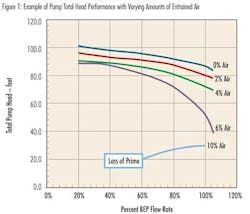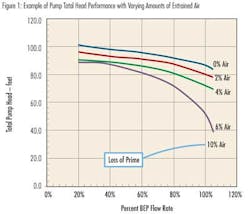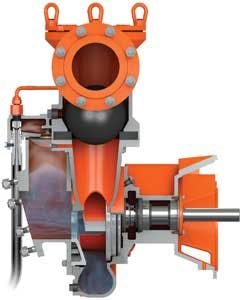Considerations for Centrifugal Pump Priming
By Allan R. Budris
Two of the writer's previous columns have touched on the few positive (June 2009) and many negative (January 2010) effects of entrained air on the performance of a centrifugal pump. This includes the possible complete loss of prime, which happens when air/gas accumulates in the eye of the impeller, to the point where it completely blocks the flow of liquid through the pump. This column is intended to expand on the various means available to prevent and/or re-establish the all critical pump prime, to insure the required pump flow.
The head-capacity impact of various amounts of entrained air on a typical centrifugal pump can be seen in Figure 1. The performance effect of entrained air on individual pumps will vary, however, since the specific impact is affected by many variables, including the pump specific speed, operating speed, impeller design, number of impeller vanes, operating point on the curve, and suction pressure. Operation of a conventional pump in the fully air bound condition for an extended period of time can cause overheating and pump failure (seizing of the impeller in the casing).
Centrifugal pumps are designed to pump liquids not gases. Any centrifugal pump (even a self-priming pump) will not start pumping unless at least the first stage (such as in a multistage vertical pump) is full of liquid. When pumping a liquid with an excessive amount of entrained air, the air/gas tends to be centrifuged inward towards the eye of the impeller, eventually blocking any liquid flow through the pump (air binding it). If this only happens occasionally, the pump has a positive suction pressure (flooded suction), and the flow stoppage can be quickly detected, stopping and restarting the pump can clear up the air binding.
However, if the pump must pull a lift, or could over heat from the flow stoppage, one (or a combination of) the following system design changes should be considered:
1. Add a foot valve in the suction line, so that the pump will remain flooded when the pump is stopped, however, foot valves can leak over time.
2. Attach a small self-priming pump to the discharge side of the primary pump, and operate it when the main pump looses prime, to remove any air in the primary pump and suction piping.
3. Install a water ejector to the pump discharge pipe, to prime the pump when necessary.
4. Replace the above ground pump with a vertical turbine, sump or submersible pump, where the pump (at least the first stage) is flooded at all times. This may require creating a pit or sump.
5. Replace the above ground pump with a self-priming pump capable of handling the total flow requirement. The efficiency of a self-priming pump will, however, be typically lower than for its non-self-priming counterpart, due to the additional liquid turns and close impeller/casing volute tongue clearance in a water-primed self-priming pump. The energy required to drive a separate vacuum pump, or compressor, for air/vacuum-primed pumps, must also be taken into account in the efficiency evaluation.
Self-Priming Pumps
Self-Priming pumps are designed to have the ability to prime themselves automatically, when operating under a suction lift, to free themselves of entrained gas, without losing their prime, and to continue normal pumping without attention. They can be broken down into three basic types: liquid primed, compressed air primed and vacuum primed.
Liquid Primed Self-Priming Pumps
Water primed self priming pumps (which are the most common) must have a priming chamber (integral or separate) that must be filled with liquid in order to for the pump to "self prime". Without this initial liquid charge, a water primed self-priming pump will not prime or pump. They generally work by disturbing the air bubble blocking the impeller suction eye, and stripping off the dislodged air with the volute tongue, which operates very close to the impeller outside diameter (much closer than for a typical centrifugal pumps). The stripped air, being much lighter than the liquid, will float to the top, while the liquid falls back into the pump casing. If the attached discharge piping does not allow this separated air to escape out to the down-stream discharge pipe system, a bypass line may be required to evacuate it.
As the air is evacuated from the pump, it generates a vacuum in the suction pipe, which after a short period of time (dependent on the suction pipe size, static lift, and any air leakage) should prime the pump, and establish full liquid flow. Excessive priming times, more than about 10 minutes, could, however, cause the liquid charge in the pump to vaporize before priming is achieved, causing damage to the pump.
For outdoor installations a heating element may be required to prevent freezing of the liquid charge. For dirty services, a strainer may be required to keep solids from accumulating in the priming chamber and displacing the priming liquid. This could, however, be a problem for sewage handling pumps.
This pump type is typically only available for low to medium flow rates (to about 2,500 - 5,000 gpm), and heads to about 600 feet.
Compressed Air Primed Self-Priming Pumps
Xylem's Godwin Pumps and John Brooks' Gorman-Rupp (and possibly others) manufacture lines of centrifugal self priming pumps that use compressed air, instead of a liquid charge, to automatically prime the pump. Compressed air is blown through a jet into a tapered tube to create a vacuum, so air from the pump casing and suction line is drawn in with the compressed air and exhausted to the atmosphere. A non-return ball check valve seals out air from the discharge, allowing fluid to enter the pump body. Water then replaces the air which allows the pump to begin pumping. This pump type also avoids the potential build up of solids, since it has no priming chamber, so it can be used for sewage applications, plus it has dry running capability. They are available to flow rates up to about 10,000 gpm. The Godwin pump also uses the Flygt two vane N Impeller design to improve efficiency, while handling solids.
Vacuum Pump Primed Self-Priming Pumps
This pump type (manufactured by Gorman-Rupp and others) typically has a vacuum pump and positive sealing float box installed at the pump discharge, close to the discharge valve. This allows it to pull a vacuum on the pump until it is full of water. Note that the maximum height that water can be lifted with a vacuum is 34 feet (at sea level), and that is with a perfect vacuum, and no liquid flowing. The pump NPSHR must also be taken into account (including a reasonable margin) when determining the maximum lift that a pump can handle. This pump type can have dry run capability, and is also capable of handling sewage. They are available up to flow rates of about 17,800 gpm.
Other Priming Considerations
Care should be taken with all self priming pumps to insure that there is no air leakage through the pump shaft seal. Further, the pump suction pipe should be designed such that no high points are created, where air can be trapped/accumulated, thus prevent priming.
About the Author: Allan R. Budris, P.E., is an independent consulting engineer who specializes in training, failure analysis, troubleshooting, reliability, efficiency audits and litigation support on pumps and pumping systems. With offices in Washington, NJ, he can be contacted via e-mail at [email protected].


